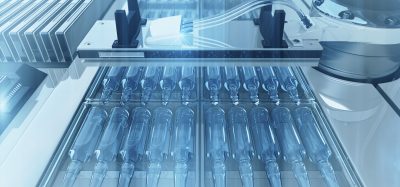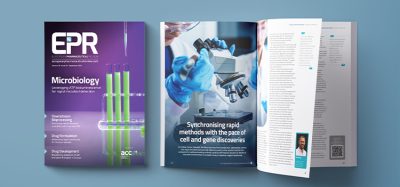Process Analytical Technology: An industry perspective
Process Analytical Technology (PAT) is a system for designing, analysing and controlling pharmaceutical manufacturing processes through measurements of critical quality and performance attributes of raw and processed materials to ensure final product quality, the idea of which is to become more efficient while reducing over-processing, enhancing efficiency and minimising waste. In this roundtable, three leading pharmaceutical PAT companies offer their opinions on why PAT is becoming more and more essential to the pharmaceutical industry…
What industry needs does Process Analytical Technology meet?
Rick E. Cooley (Market Development Manager – Process Analytics at the Dionex Corporation):
Viewing this question from the regulator’s perspective, Process Analytical Technology is primarily focused on reducing process variability. Integrating on-line measurement and/or modelling of critical quality attributes with automated feedback control of the process parameters impacting these attributes should reduce product variability. Reducing product variability will subsequently reduce the risk of releasing off-spec product into the marketplace. The push is to shift away from the historical quality assurance approach (i.e. testing quality after the process is complete) to a true quality control approach where the process is continually adjusted to maintain product quality. In addition, there are the benefits of cycle time reduction and increased process efficiency (e.g. increased yield, throughput and equipment utilisation) that are achieved by eliminating the delays associated with off-line assays, as demonstrated by Eli Lilly’s ten-fold increase in throughput enabled by moving HPLC assays on-line. Identification of critical-to-quality process parameters and their optimum operating ranges should be accomplished much more efficiently with PAT in place throughout the process development and product manufacturing life cycle. Although this may be difficult to quantitate, it was a benefit of implementing on-line ion chromatography to measure amino acids that was cited by Genentech.
Uwe Kirschner (General Manager at Sentronic GmbH, Dresden):
High regulatory requirements have resulted in nearly static manufacturing processes and production technology in the pharmaceutical industry in the last few decades. Thus in terms of automation and process control, the pharmaceutical industry is significantly behind other industries. But yes, there is a significant need to increase process knowledge and for improvements. Process Analytical Technology is an important part in the puzzle that will help the pharmaceutical industry to produce more flexibly at a lower cost and with consistently high quality. PAT helps generate process knowledge by opening the black box of various production steps. As such, it can be a relatively simple tool for process troubleshooting in process development or routine operation. Applied early in product development using design of experiment concepts, a design space for the production process can be developed. Applying PAT to existing products might be economically difficult, as long as refilling the product with the new, more flexible process is the goal. Last but not least, PAT is a door opener for continuous production processes, where in-line control is essential to achieve constant high quality.
Rebecca Vangenechten (Siemens):
Process Analytical Technology can get products to market faster. Just in time manufacturing enables manufacturing flexibility through better process under – standing, which allows for a more rapid response to changing marketing needs. Small batch production for personalised medicine, manufacturing flexibility through better process understanding, allows a faster turnaround of the production-line for nearly-different product formulations. PAT enables quality cost reduction by moving quality control closer to the production-line (in-line, on-line, at-line) and away from the quality labs. PAT results in operational excellence, higher yields through concepts like real time monitoring and control of one unit operation or when applied throughout the entire production-line continuous manufacturing. PAT can reduce waste, achieving green manufacturing.
Which areas of pharmaceutical manufacturing are affected by Process Analytical Technology?
Kirschner:
Virtually all areas of pharmaceutical manufacturing are affected by Process Analytical Technology. This is logical since the basic concepts are not limited to any part of the production process. But usage level and potential benefits of PAT are not equal. It’s all a question of achievable benefits, know-how and industry experience.
From our view and experience nowadays, one of the most common PAT applications in solid dose manufacturing is the use of PAT analysers (mainly NIR) for end point detection in powder blending. But it took about 10 years to get there from the first industrial applications by Pfizer and others! Currently we see progress being made on granulation processes, drying and continuous manufacturing. These developments have been ongoing for a couple of years now. Here the reasons for applying PAT are easily understood: fast processes such as high shear mixing and granulation are hard to control without PAT. The same issues occur in continuous manu – facturing processes.
Cooley:
Process analytics can be applied throughout the manufacturing value chain from API production to drug product manufacturing. Process analytics can also be applied to ancillary operations such as preparation of buffers and reagents used in the manufacturing process and waste stream monitoring. Continuous waste stream monitoring with process analytics such as on-line HPLC can help minimise regulatory risk (from an environmental discharge perspective) and provide continuous data on how much material is being lost from the process. The latter may provide important information on what process steps could be improved to minimise losses and thus increase production yields as well as improve process greenness. As concerns about the amount of pharmaceuticals being detected in waterways continue to increase, this may become a widespread application for process analytics.
Kjell François:
On the one hand, Process Analytical Technology can be applied at late stage process development for new products with an emphasis on getting the product to market as fast as possible, using the patent life of the product to its fullest.
On the other hand, PAT can be embraced in the commercial manufacturing environment. In this constellation, PAT can be used as a way to have quality control closer to the line (at-line) or even in real time (on-line, in-line). Or PAT could be implemented to be used as an input value for advanced process control, controlling, for example, a continuous process in real time.
How do you implement a successful Process Analytical Technology strategy within the pharmaceutical industry?
Cooley:
Senior management must create an environment that is conducive to supporting the change initiative and associated risk-taking. It is critical to have a team approach with players representing the key stakeholders such as manufacturing, analytical, statistics, process automation, regulatory, QC, etc. One implementation approach is to apply Process Analytical Technology to an entire process when a new product moves through process development. This approach may work with a company that is more experienced with PAT, but is difficult for a company just starting to implement PAT. I would recommend a more stepwise approach where PAT is implemented using a platform method. That is to choose a unit operation such as drying and apply a Quality by Design approach that includes PAT. Once the approach has been applied to a particular unit operation, it can be applied to another unit operation until the entire process has been transformed. This approach can be used for a new product coming through process development, an existing process that has significant issues in a particular manufacturing step, or even off-line to develop your PAT approach using a surrogate material to simulate a process operation.
Vangenechten:
The starting point has to be the vision of where the company wants to be in 10 – 15 years time and how this will impact manufacturing methods and practices. For example, a company may choose to implement relatively modest improvement investment in a plant that is manufacturing a product that is nearing the end of its patent life. Elsewhere, it may choose to plan for a rapid and full scale move to process analytical technology (PAT) enabling full realisation of the FDA’s vision of real time product control and release, based on continuous manufacturing operations. Moreover, companies will face a choice between big plants with flexible recipe production versus small scale development (pilot) plants which will also be production facilities with dedicated lines. For both models of production, industrial IT systems will play a strategic role, requiring tremendous flexibility, in the first model to support the flexibility of production that will be necessary and in the second smaller scale model to link production with continuous development and learning from clinical trials.
Kirschner:
Process Analytical Technology should be implemented as a company-wide concept to fully use the benefits long term. To begin, a certain product or unit operation which is especially critical to control should be selected. After the successful implementation on a selected unit operation, it will be much easier to adapt it to the next production step within a plant. For each implementation, realistic expectations and goals that are based on the current experience are needed. Taking the right approach according to the goals is crucial in our experience. In all cases, a certain level of internal know-how needs to be built up, even though close co-operation with suppliers, consultants and authorities will help to find an efficient path through PAT projects.
An unbiased look at financial figures will help to define realistic goals. QbD and real time release are not always the only answers. We believe more attention should be paid to the use of PAT tools in process development, product transfers and process troubleshooting. Here useful experience can be made without the full implementation of a filed process. Avoiding a single batch failure could pay for the investment. If you found the root cause of a process problem, you might be able to correct it without a major process change.
What are the major obstacles in implementing Process Analytical Technology methodologies to the pharmaceutical manufacturing industry?
François:
The technical issues include data centralisation, connectivity to the different data sources (analysers, databases, process control systems, etc) and data management (collection, alignment, aggregation and contextualisation). Validation strategies require high effort, revalidating existing processes and a lack of experience in other projects/filings. As for management vision, quality is seen as a cost. With the lack of a good business case, it is difficult to quantify the value of QbD and hard to calculate a ROI. There can be a fear of the complexity and multidisciplinary character of Process Analytical Technology and there is a high doorstep for smaller companies. There is also sometimes a fear of change.
Cooley:
In my opinion, the major obstacle is the pharmaceutical industry’s risk-averse culture. Any change in the way things have historically been done is viewed as risky and therefore to be avoided. This is further compounded by the current industry environment where over 100,000 people have been laid off recently due to the loss of venture capital, M&A, recalls of approved products, etc. In this atmosphere, no one wants to be responsible for a change that results in delaying the approval of a process or plant. I think another obstacle is the lack of clarity around what Process Analytical Technology and QbD mean from an implementation perspective. The ICH has done an excellent job in helping clarify the QbD approach, but I believe broader collaboration between the industry, regulatory agencies and academia on actual implementation of QbD and PAT (i.e. the ‘how’ to go along with the ‘what’) could be very helpful in reducing the obstacles.
Kirschner:
Since Process Analytical Technology is a key element of a paradigm change in the pharmaceutical industry towards operational excellence, its implementation involves deep organisational changes. Most of the PAT implementations in industry so far have most likely not realised a financial return on investment. The industry is still in the ‘investment phase’. At first look, this makes it difficult to make new decisions for PAT projects.
We see other hurdles in the complexity of the matter. There is a need for intense communication, often over cultures and countries and the involvement of different organisation levels. Often a new structure with dedicated resources is required. This is something, which typically needs to grow over the years.
In terms of technology, we see the need to improve the instrumentation to simplify validation processes and the development of even more unit operation specific solutions, based on fit-for-purpose standard instruments.
What do you see as being the future of Process Analytical Technology developments in the pharmaceutical industry?
Vangenechten:
We see a move towards open standards for data communication, e.g. OPC UA. We see new and optimised measurement techniques – cell on a chip, smaller faster and more flexible measurement techniques, such as NESSI. There may be a shift from chemical to bio after the first successful implementations and a shift from batch to continuous processes; focus on smaller scale, higher throughput.
Kirschner:
The long-term benefits of Process Analytical Technology can be clearly demonstrated. There was hype for PAT a few years ago but I’m seriously convinced that PAT is playing an increasing role within the whole pharmaceutical industry, yet it will take many years to gain the experience and know-how required.
But things need to get simpler and easier to implement and operate. At the beginning of the age of cars, market potential was seen as limited, because there were not enough engineers to drive the new vehicles. History has shown us how to overcome such deficiencies.
Instrumentation and software still have to become even more user friendly and cross-linked. New standards such as the OPC-UA ADI for analyser interfaces are a good step forward. Also, overall project cost (including the investment into equipment) will become a bigger topic when the roll-out of technology is taking place. Simplified and standardised approaches for calibration and model development could help to bring the implementation cost down to levels that are more acceptable.
I believe we will continue to see a slow rate of PAT implementation until price pressures move the industry to recover savings wherever they can be found. Another driver for PAT implementation will come when the industry moves from large scale, batch processes to smaller scale, continuous operations. This will likely occur when personalised medicines become the norm, resulting in reduced lot sizes. At that point, manufacturing will be smaller scale reactors running 24/7 with on-line analysers providing data for feedback control of the process. We may even see a future where micro reactors produce a base API molecule that is fed directly to other micro reactors that modify the base molecule to produce API customised for populations X, Y and Z. On the large molecule side, I believe we will reach a level of understanding cellular reactions where active control of metabolic pathways impacting critical quality attributes such as glycosylation will become possible while the cells are in the bioreactor. This control will be enabled by PAT systems composed of on-line liquid chromatographic devices coupled to liquid introduction mass spectrometers to produce the metabolomic analyses.
About the participants
Uwe Kirschner
Uwe Kirschner is General Manager at Sentronic GmbH, Dresden and responsible for the Process Analyser business unit. He completed his Diploma in Information Technology at the Technical University Dresden in 1994. For more than 10 years, Uwe and Sentronic Process Analysers have focused on process analytical technology. Since 2004, Pharma PAT-based on NIR analysers has been developed as the core business.
Rick E. Cooley
Rick E. Cooley is currently the Market Development Manager – Process Analytics at the Dionex Corporation. He joined Dionex after a 32 year career at Eli Lilly and Company where he was most recently the team leader of the Process Analytical Measurement Technology group and corporate leader of process analytics. While at Eli Lilly, Rick was a member of the FDA’s Process Analytical Technology Advisory Sub-Committee and PAT committees associated with PhRMA, PDA, ASTM and USP. He is the founding organiser of the Pharma Process Analytics Roundtable (PPAR) and has served the International Forum on Process Analytical Chemistry (IFPAC) conference since 1994 as a board member, session organiser and past conference chairman.
Rebecca Vangenechten
Rebecca Vangenechten is responsible for business development life sciences US and focuses on innovative technologies, including Process Analytical Technology (PAT), out of the Siemens Headquarter Pharma, located in Antwerp (Belgium). She holds a Msc. in BioMedical Sciences from the Catholic University of Louvain and a Masters in Global Management from the University Antwerp Management School.
Kjell François
Kjell François is a project leader in Process Analytical Technology at Siemens, with experience in both the food sector and pharmaceutical industry. Kjell’s specialities are defining and implementing solutions for complex multi-layer problems in regulated and validated environments.








